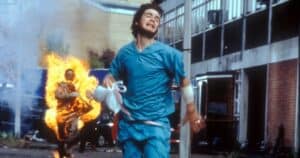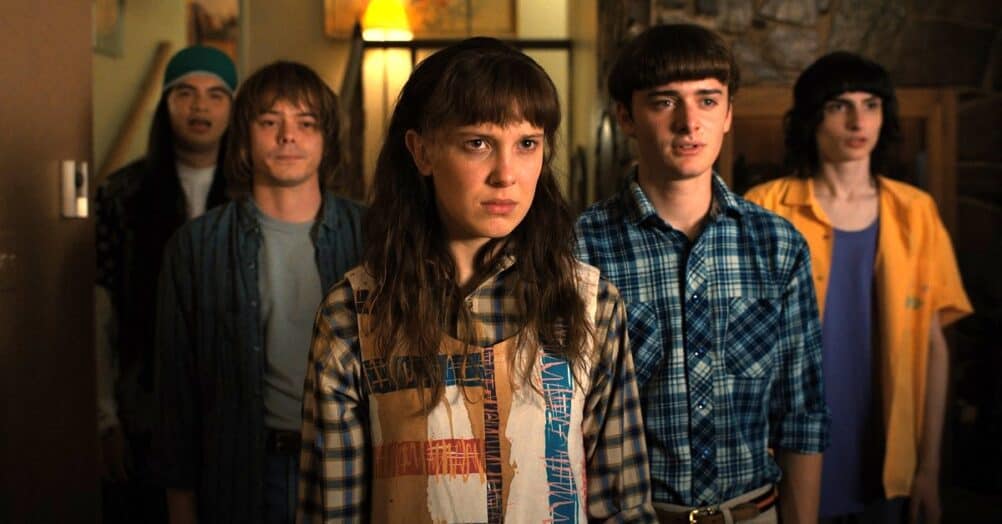Last Updated on July 30, 2021

We all have certain movies we love. Movies we respect without question because of either tradition, childhood love, or because they’ve always been classics. However, as time keeps ticking, do those classics still hold up? Do they remain must-see? So…the point of this column is to determine how a film holds up for a modern horror audience, to see if it stands the Test of Time.

DIRECTED BY ADRIAN LYNE
STARRING TIM ROTH, ELIZABETH PENA, DANNY AIELLO, VING RHAMES, JASON ALEXANDER
Here’s one for ya: what’s your all-time favorite horror movie head-trip?
When it comes to the most terrifying psychological horror films, the most sensorially vexing of surreal cinematic nightmares ever conjured, Adrian Lyne’s JACOB’S LADDER (WATCH IT HERE) has to top the list. What a scary-ass and deeply unnerving movie! It had been a while since personally viewing the film, likely due to the subconscious fear I knew it would tap into once again and the nauseating feeling in the pit of my stomach it would surely induce. It’s truly that upsetting. That memorably wounding. The risible remake released in 2019 on the other hand? Absolute hogwash. Poppycock. Balderdash. F*cking falderal!
The hellish, religiously-tinged purgatorial hallucination of a man grappling with death in the wake of the Vietnam War did not do well at the box-office at the time of its release in 1990, something star Tim Robbins attributed to the American public’s weary sentiment in the lead-up to the Gulf War. Now, as the film celebrates its 30th anniversary this autumn, let’s find out once and for all how JACOB’S LADDER contends with the Test of Time!

THE STORY: According to screenwriter Bruce Joel Rubin (GHOST), the story was heavily influenced by the Tibetan Book of the Dead, Bardo Thodol, the Biblical tale of Jacob’s Ladder, and the Oscar-winning 1961 short film OCCURRENCE AT OWL CREEK BRIDGE. The film opens in Vietnam, where a squadron of U.S. soldiers sits and idly chitchats while smoking some strong dope. Right before an enemy onslaught, several of the soldiers begin convulsing with severe mental trauma, likely from the substance they just inhaled. Jacob Singer (Robbins) gets lost in the skirmish, only to be stabbed with a bayonet and left to die in the jungle. The film cuts to the present, where Jacob now works in New York as a U.S. Postman despite earning a doctoral degree.
Reeling from severe PTSD from his time in Vietnam and the grief over losing his young son Gabe (Macauley Culkin) in an accident prior to enlisting, Jacob is in bad shape. He has physical “back” problems, prompting visits to chiropractor Louis (Danny Aiello). But the back also refers to the past, which is really what ails him and his tumultuous psychological state. Divorced from wife Sarah (Patricia Kalember) and his other Biblically named children, Jed and Eli, Jacob lives with sexy girlfriend Jezzie (Elizabeth Pena). From the instant we meet Jake in NYC, he’s plagued by a rash of schizoid paranoia, haunting hallucinations, and the feeling he’s being chased by some demonic scourge. When he begins to think that army experimentation left him in a state of despair and disrepair, Jake reaches out to fellow Nam survivors who also suffer similar turmoil. The closer Jake comes to finding answers, the deeper into the hellish abyss of scarifying memories he sinks.

WHAT HOLDS-UP: Having just revisited the film for the first time in nearly a decade, I can say with brimming confidence that the emotional impact JACOB’S LADDER has not waned a bit. Once again this movie left me queasily disoriented, highly anxious, and constitutionally shaken. A barrage of factors contribute to the staying power of the picture, but we’d be remiss not to mention the sheer directorial imagery, superb practical FX, and the central turn by Robbins among the sturdiest aspects of the film when viewed with fresh eyes.
Adrian Lyne drew visual inspiration from the photography of Joel-Peter Witkin and his 1976 work “Man With No Legs.” He also drew from painter William Blake, H.R. Giger, Francis Bacon, and Diane Arbus for the visual tableau of the film. Thematically, Lyne was tapping into the controversial drug BZ, aka 3-quinuclidinyl benzilate, an experimental hallucinatory used on U.S. Soldiers in Vietnam. Between this dynamic and the overt religious symbolism and iconography, the imagistic appearance of JACOB’S LADDER is meant to perfectly mirror Jacob’s mental state. The city is ugly, dirty, and decaying, just as Jake’s body was left in the mud after a fatal battle wound. Cinematographer Jeff Kimball (TOP GUN, TRUE ROMANCE) perfectly conjures an air of surrealism in every frame, keeping the audience as bemused and off-kilter as Jake himself.

Originally, the biblical parallels were going to be far heavier-handed with the horned and winged serpents, cloven-hoofed beasts, a giant ladder extending to the cosmos, etc. However, it was Lyne’s idea to nix the obvious references in the script and keep things closer to the vest. Lyne was afraid of the audience laughing at such over the top imagery and dialed the script back to intimate the thalidomide scandal of the late-50s, a pregnancy drug that resulted in thousands of deformed newborns. Lyne’s haunting imagery in the film reflects such, particularly in the hospital and operating room scenes.
To achieve a lasting authenticity, Lyne wisely opted to create every VFX on-set and in-camera. Not a single CGI is featured in the film, which will forever shroud its age. For instance, during the iconic “head-shaking” shot where Jake wheels through a hellish gauntlet of invalids, the effect was achieved by having the actor wave his ahead around at normal speed. Lyne then filmed the action at 4fps, which made the action appear frenetically fast when played back at the typical frame-rate of 24fps. Another subtle trick Lyne uses to confuse the audience is always that Jacob is never seen in the same shot with one of his hallucinations.

As for Robbins’ performance, it’s hard to imagine any other actor giving such a convincing turn in the film. Everyone from Mickey Rourke, Al Pacino, Dustin Hoffman, Richard Gere, and Don Johnson were considered for the role, none of which I can even envision as Jacob Singer after the work Robbins does in the film. He’s a reactionary blank slate, which allows the audience to project their own interpretations of what his happening to him as the film unspools, particularly the first time you watch it. Your heart breaks for this guy who’s seen so much loss, pain, and grief while sacrificing for his country.
WHAT BLOWS NOW: Given how much better the film has been received since its weak box-office debut, what blows now is how much footage Lyne excised in the wake of poor test screenings. Roughly 20-minutes of footage was cut from the original edit of the film, many bits and pieces of which were featured in the movie’s trailers and TV spots. For instance, the original opening featured Jacob witnessing a man being raped in the subway before he is chased by an unknown figure.

In addition, four critical sequences were nixed in favor of a shorter, more focused runtime. They include Jacob meeting Michael (Matt Craven in yet another biblically-named character) for the first time, Michael giving Jacob a remedy for the ladder, finding Michael decapitated, and perhaps the most regrettable, a major showdown between Jake and Jezzie, whose body turns itself inside out until her true form as a massive demon is revealed. Prior to ascending to the staircase (ladder) with Gabe, Jake would have battled Jezzie’s demonic form prior to his final salvation. It blows that none of these are featured in the finished version, although they can be found online.
THE VERDICT: Having aged 10 or 12 years since last watching it, I fully expected JACOB’S LADDER to be far tamer than my memory suggested. Not the case. This movie is still wildly jarring, highly unsettling, and deeply affecting. The movie still evokes the targeted mood and elicits the intending feelings in the viewer, leaving those who sit through the experience a shook, mentally spun-out wreck. It’s a first-rate piece of psychological terror that not only f*cks with your mind as a nightmarish hallucination but also a visceral gut-punch that you can feel bruising your solar plexus in the process of witnessing it. Thirty years later JACOB’S LADDER still ain’t for the faint of heart or the weakened mind!





















Follow the JOBLO MOVIE NETWORK
Follow us on YOUTUBE
Follow ARROW IN THE HEAD
Follow AITH on YOUTUBE